Honey Ramka
56 Bogart Street
Brooklyn NY
December 7 - January 13
A blocky rectangular face with a thin pointed nose is absorbed in a transcendent moment. He's bathed in a warm pink light. His melancholic expression fills the whole image. Tears flow down his face, rendered solid and static as they cast harsh shadows across his cheek. As if it were not saline but pale blue iron falling from his closed eyes. This exercise of capturing the moment one is lost in their own senses is at the core of Nat Meade’s paintings.
Nat Meade renders a language of sensory stimulation through a language of color and shape. His work reads as autobiographical in the way that describing the viscosity of a milkshake you had with dinner last week is autobiographical. The subject of your memory is long gone, pushed out the other end, consumed. No longer tangible, and never will be in that state again. The only way we can resurrect it from the ashes of memory is to relay it back through our bodily experience.
The artist relays this through a language of vibrating color relationships and rounded human forms. His figures act as guides for the viewer to project their own bodily experience on. In one painting, a network of round-edged rectangles comes together to form a head blissfully suckling on an equally rectangular ice pop. A cool Granny Smith green is brushed over the deep orange underpainting, making the ice pop glow with all the freshness of a tart lime sherbet or, icy mint. In another piece called Gust, a male figure with a flowing beard and golden blonde hair holds a flower to his nose. Stubby splotches of pink paint become flower petals swirling around him in a moment of psychedelic envelopment.
At the time of me writing this, this show is in its last days. Soon these paintings will be taken down, sent to their respective owners, and will go on to live their own lives. In a way my attempts to frame a snapshot of Honey Ramka’s walls are a mirror to Nat’s attempts to capture the smell of a flower whose petals have long since flown away in the wind.
